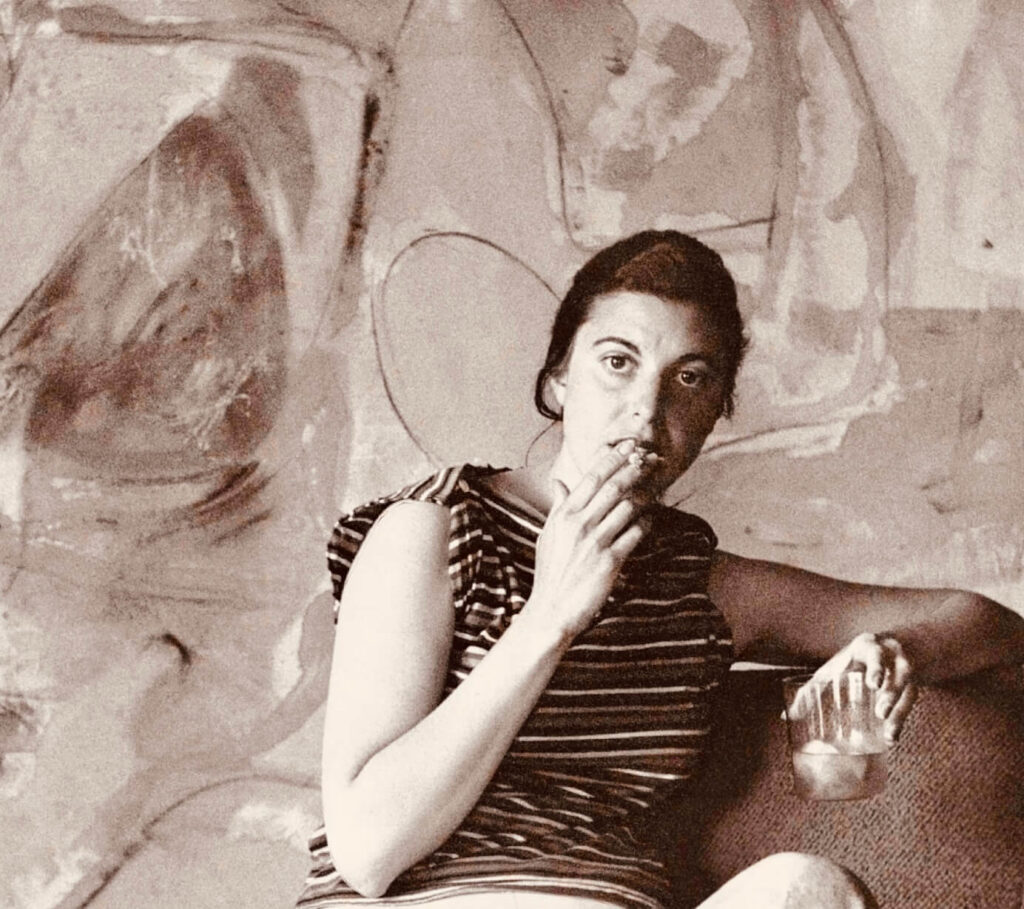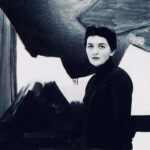Helen Frankenthaler
Helen Frankenthaler (1928-2011) was a pioneering American abstract expressionist painter known for her innovative techniques and vibrant use of color. Her contributions to modern art have had a lasting impact on the development of abstract expressionism and color field painting. This biography delves into Frankenthaler’s life, career, and three of her most significant artworks, highlighting her influence on the art world.

Early Life and Education
Helen Frankenthaler was born on December 12, 1928, in New York City into a cultured and intellectual family. Her father, Alfred Frankenthaler, was a respected New York State Supreme Court judge, and her mother, Martha Lowenstein, was a German immigrant. Growing up in an environment that valued education and the arts, Frankenthaler was encouraged to pursue her creative interests from an early age.
Frankenthaler attended the progressive Dalton School in New York, where she studied under the influential art teacher Rufino Tamayo, who introduced her to the work of European modernists and encouraged her to experiment with abstraction. After graduating from Dalton, she enrolled at Bennington College in Vermont, where she studied under painter Paul Feeley. At Bennington, Frankenthaler was exposed to a range of artistic styles and techniques, which laid the foundation for her future work.
Early Career and Breakthrough
After graduating from Bennington College in 1949, Frankenthaler returned to New York City, where she became part of the vibrant post-war art scene. She studied briefly with Hans Hofmann, a German-American painter and teacher known for his abstract expressionist works. Hofmann’s emphasis on color and composition had a profound influence on Frankenthaler, inspiring her to explore new ways of working with paint.
In the early 1950s, Frankenthaler began to develop her own distinctive style, characterized by large-scale canvases and innovative techniques. Her breakthrough came in 1952 with the creation of “Mountains and Sea,” a seminal work that would establish her reputation as a leading figure in abstract expressionism.
“Mountains and Sea” (1952)
“Mountains and Sea” is perhaps Frankenthaler’s most famous work and a pivotal piece in the history of modern art. The painting is a large, horizontal canvas featuring translucent washes of color that seem to float across the surface. Frankenthaler created the piece using a technique known as “soak-stain,” in which she thinned oil paint with turpentine and poured it directly onto the unprimed canvas, allowing the colors to soak into the fabric.
The result is a luminous, ethereal composition that evokes the natural landscape without directly depicting it. The title “Mountains and Sea” suggests a connection to the natural world, reflecting Frankenthaler’s fascination with the beauty and complexity of nature. The painting’s innovative technique and abstract forms had a profound impact on her contemporaries, particularly Morris Louis and Kenneth Noland, who adopted and further developed the soak-stain method in their own work.
Development of the Soak-Stain Technique
Following the success of “Mountains and Sea,” Frankenthaler continued to refine and expand her soak-stain technique. She experimented with different materials and methods, creating a diverse body of work characterized by its vibrant colors and dynamic compositions. Her paintings from this period often featured large, flowing areas of color that seemed to merge and overlap, creating a sense of movement and depth.
In the 1960s, Frankenthaler’s work evolved to include more structured compositions and a greater emphasis on geometric forms. She began to use acrylic paint, which allowed her to achieve more intense colors and varied textures. Despite these changes, her work retained the spontaneity and fluidity that had become her trademark.
Important Artworks
Three of Frankenthaler’s most significant artworks are “The Bay” (1963), “Jacob’s Ladder” (1957), and “Canyon” (1965), which exemplify her mastery of color, composition, and innovative techniques.
“The Bay” (1963)
“The Bay” is a large, abstract painting featuring a luminous expanse of blue that seems to flow across the canvas. The painting was created using Frankenthaler’s soak-stain technique, with thinned acrylic paint poured and spread across the surface. The result is a vibrant, almost ethereal composition that evokes the tranquility and beauty of a body of water.
“The Bay” was included in the 1964 Venice Biennale, where it received widespread acclaim for its innovative use of color and form. The painting exemplifies Frankenthaler’s ability to convey a sense of place and emotion through abstract means, capturing the essence of a natural landscape without directly depicting it.
“Jacob’s Ladder” (1957)
“Jacob’s Ladder” is another important work in Frankenthaler’s oeuvre, created during a period of intense experimentation and innovation. The painting features a complex composition of overlapping shapes and colors, with translucent washes of paint creating a sense of depth and movement. The central motif, a series of vertical lines and shapes, suggests the image of a ladder ascending into the sky.
The title “Jacob’s Ladder” refers to the biblical story of Jacob’s dream, in which he saw a ladder reaching to heaven. The painting’s abstract forms and vibrant colors evoke a sense of spiritual ascent and transcendence, reflecting Frankenthaler’s interest in the relationship between the physical and metaphysical worlds.
“Canyon” (1965)
“Canyon” is a large-scale painting that exemplifies Frankenthaler’s mature style, characterized by bold, flowing areas of color and dynamic compositions. The painting features a vibrant expanse of orange, yellow, and red, with shapes and forms that seem to merge and overlap. The use of acrylic paint allows for intense, saturated colors that create a sense of energy and movement.
The title “Canyon” suggests a connection to the natural landscape, reflecting Frankenthaler’s fascination with the beauty and power of the natural world. The painting’s dynamic composition and vibrant colors capture the essence of a canyon, with its steep walls and dramatic vistas.
Legacy and Influence
Helen Frankenthaler’s legacy as an artist lies in her ability to create a unique visual language that bridges the gap between abstraction and representation. Her innovative use of the soak-stain technique and her mastery of color and composition have left a lasting impact on modern art, influencing generations of artists and viewers.
Frankenthaler’s works are included in the collections of major museums and galleries around the world, including the Museum of Modern Art in New York, the Whitney Museum of American Art, and the Tate Gallery in London. Her contributions to abstract expressionism and color field painting continue to be celebrated through exhibitions and retrospectives.
Personal Life and Philosophy
Frankenthaler’s personal life was as vibrant and complex as her artwork. She was married twice, first to fellow artist Robert Motherwell and later to investment banker Stephen DuBrul. Throughout her life, Frankenthaler maintained a deep commitment to her art, often drawing inspiration from her experiences and surroundings.
Frankenthaler viewed her paintings as a form of exploration and discovery, a way to engage with the world and express her inner vision. She believed in the power of color and form to convey emotion and meaning, and her work often reflects a deep sense of wonder and curiosity about the natural world.
Conclusion
Helen Frankenthaler’s artistic journey is a testament to her creativity, resilience, and profound understanding of color and form. Through her innovative use of the soak-stain technique and her dynamic compositions, she created a body of work that continues to inspire and challenge viewers. “Mountains and Sea,” “The Bay,” “Jacob’s Ladder,” and “Canyon” are just a few examples of her ability to convey complex ideas and emotions through abstract forms and vibrant colors. Frankenthaler’s legacy as a pioneer of abstract expressionism and a master of color ensures that her work will continue to resonate with audiences for years to come.



